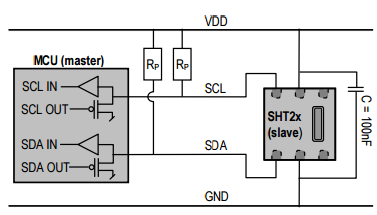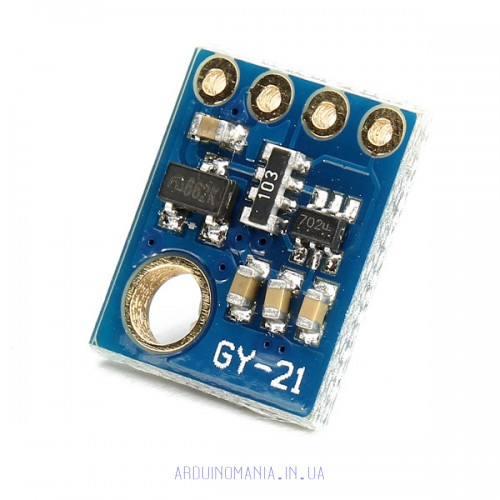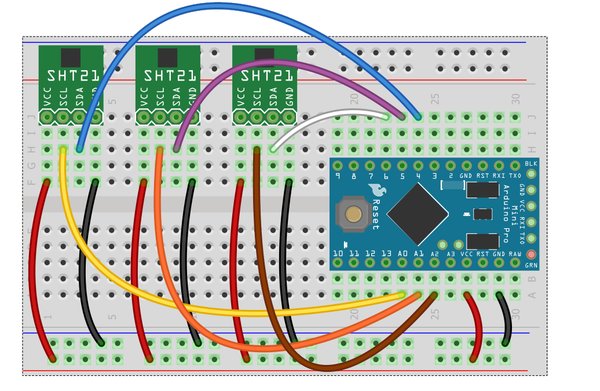SHT21D I2C and WIPY2
-
I have the SHT21(D) temperature / humidity sensor hooked up to the WIPY2 with 10K pullups on SDA and SCL, however it cannot be discovered.
I am sure that the device is not fried and was new from element 14 last Friday.
If I connect another I2C device (24C01 Eeprom) then it returns the device correctly, however the SHT21 refuses to cooperate.
I know you don't have much to go on, but any suggestions on how to debug or what the cause may be ??
from machine import I2C i2c = I2C(0, I2C.MASTER, baudrate=100000) print(i2c.scan())
-
@affoltep
How do I get normal decimal values?
-
@affoltep Thanks, I am using the three properties from measure separately. (self.temperature, self.humidity, self.dewPoint)
I do a string conversion and send them as JSON. So before converting to a string, I have these float values?Should I convert these into a byte array to convert it into a network byte order? I am about to read these values back in C#.
-
@lollisoft if you are asking about sht1x then you find two methods to read raw temperature and raw humidity values in the class which are binaries. If you talk about SHT 2x, then you can read raw values over the i2c interface.
Hope this is the fitting response to your question.
-
@affoltep Is there any way to encode the values in a compact binary format?
-
@affoltep thank you very much
you read my thought about the driver ! I was wondering how can I get it for the pycom!
-
@maamar I use the standard pins P9 for SDA and P10 for SCL. The point with the SHT10 is that it does not support the standard I2C protocol which works for the SHT2x. You need to use a dedicated lib. I ported a SHT15 python library to the syntax of the pycom. Feel free to use it for your application.
# -*- coding: utf-8 -*- """ Sensirion SHT1x & SHT7x family temperature and humidity sensors Created by Markus Schatzl, November 28, 2008 Released into the public domain Revised (v1.1) by Carl Jackson, August 4, 2010 Rewritten (v2.0) by Carl Jackson, December 10, 2010 Ported to micropython by Frederic Mantegazza, november, 2014 Ported to pycon hardware by Peter Affolter, December, 2016 """ import math from machine import Pin import utime # Clock pulse timing (us) # Lengthening these may assist communication over long wires PULSE_LONG = 3 PULSE_SHORT = 1 # Status register bit definitions SR_LOW_RES = 0x01 # 12-bit Temp / 8-bit RH (vs. 14 / 12) SR_NORELOAD = 0x02 # No reload of calibrarion data SR_HEAT_ON = 0x04 # Built-in heater on SR_BATT_LOW = 0x40 # VDD < 2.47V # SHT1X command definitions: # adr command r/w CMD_MEAS_TEMP = 0x03 # 000 0001 1 CMD_MEAS_HUMI = 0x05 # 000 0010 1 CMD_STAT_REG_W = 0x06 # 000 0011 0 CMD_STAT_REG_R = 0x07 # 000 0011 1 CMD_SOFT_RESET = 0x1e # 000 1111 0 # Status register writable bits SR_MASK = 0x07 # Temperature & humidity equation constants D1 = -40.1 # for deg C @ 5V D2h = 0.01 # for deg C, 14-bit precision D2l = 0.04 # for deg C, 12-bit precision C1 = -2.0468 # for V4 sensors C2h = 0.0367 # for V4 sensors, 12-bit precision C3h = -1.5955E-6 # for V4 sensors, 12-bit precision C2l = 0.5872 # for V4 sensors, 8-bit precision C3l = -4.0845E-4 # for V4 sensors, 8-bit precision T1 = 0.01 # for V3 and V4 sensors T2h = 0.00008 # for V3 and V4 sensors, 12-bit precision T2l = 0.00128 # for V3 and V4 sensors, 8-bit precision class SHT1XException(Exception): """ """ class WrongParam(SHT1XException): """ """ class NoAcknowledge(SHT1XException): """ """ class Timeout(SHT1XException): """ """ class InvalidMeasure(SHT1XException): """ """ class SHT1X: """ SHT1X Sensirion management class """ def __init__(self, dataPin, clockPin): """ Init object @param dataPin: pin for data line @type dataPin: str or pyb.Pin.cpu.Name or pyb.Pin.board.Name @param clockPin: pin for clock line @type clockPin: str or pyb.Pin.cpu.Name or pyb.Pin.board.Name All functions exit with clockPin low and dataPin in input mode """ self._pinData = Pin(dataPin, mode=Pin.OUT) self._pinClock = Pin(clockPin, mode=Pin.OUT) self._rawDataTemp = None self._rawDataHumi = None self._measureInitiatedAt = 0 self._measureReady = False # Sensor status register default state self._statusRegister = 0x00 self._initSensor() @property def temperature(self): """ """ if self._rawDataTemp is None: raise InvalidMeasure if self._statusRegister & SR_LOW_RES: return D1 + D2l * self._rawDataTemp else: return D1 + D2h * self._rawDataTemp @property def humidity(self): """ """ if self._rawDataTemp is None: raise InvalidMeasure if self._statusRegister & SR_LOW_RES: humidity = C1 + C2l * self._rawDataHumi + C3l * self._rawDataHumi ** 2 humidity += (self.temperature - 25.0) * (T1 + T2l * self._rawDataHumi) else: humidity = C1 + C2h * self._rawDataHumi + C3h * self._rawDataHumi ** 2 humidity += (self.temperature - 25.0) * (T1 + T2h * self._rawDataHumi) if humidity > 100.0: humidity = 100.0 elif humidity < 0.1: humidity = 0.1 return humidity @property def dewPoint(self): """ """ k = math.log(self.humidity / 100) + (17.62 * self.temperature) / (243.12 + self.temperature) return 243.12 * k / (17.62 - k) def _initSensor(self): """ Put sensor to default state """ # Sensor status register default state self._statusRegister = 0x00 # Reset communication link with sensor self._resetConnection() # Send soft reset command self._putByte(CMD_SOFT_RESET) def _resetConnection(self): """Communication link reset # At least 9 SCK cycles with DATA=1, followed by transmission start sequence # ______________________________________________________ ________ # DATA: |_______| # _ _ _ _ _ _ _ _ _ ___ ___ # SCK : __| |__| |__| |__| |__| |__| |__| |__| |__| |______| |___| |______ """ # Set data register high before turning on self._pinData(True) # output driver (avoid possible low pulse) self._pinData.init(mode=Pin.OUT) utime.sleep_us(PULSE_LONG) # 9 clock cycles for i in range(0, 9): self._pinClock(True) utime.sleep_us(PULSE_LONG) self._pinClock(False) utime.sleep_us(PULSE_LONG) self._startTransmission() def _startTransmission(self): """Generate SHT1X-specific transmission start sequence # This is where SHT15 does not conform to the I2C standard and is # the main reason why the AVR TWI hardware support can not be used. # _____ ________ # DATA: |_______| # ___ ___ # SCK : ___| |___| |______ """ # Set data register high before turning on self._pinData(True) # output driver (avoid possible low pulse) self._pinData.init(mode=Pin.OUT) utime.sleep_us(PULSE_SHORT) self._pinClock(True) utime.sleep_us(PULSE_SHORT) self._pinData(False) utime.sleep_us(PULSE_SHORT) self._pinClock(False) utime.sleep_us(PULSE_LONG) self._pinClock(True) utime.sleep_us(PULSE_SHORT) self._pinData(True) utime.sleep_us(PULSE_SHORT) self._pinClock(False) utime.sleep_us(PULSE_SHORT) self._pinData.init(mode=Pin.IN, pull=Pin.PULL_UP) def _putByte(self, value): """ Write byte to sensor and check for acknowledge @raise: NoAcknowledge """ # Set data line to output mode self._pinData.init(mode=Pin.OUT) # Bit mask to transmit MSB first mask = 0x80 for i in range(8, 0, -1): self._pinData.value(value & mask) utime.sleep_us(PULSE_SHORT) # Generate clock pulse self._pinClock(True) utime.sleep_us(PULSE_LONG) self._pinClock(False) utime.sleep_us(PULSE_SHORT) # Shift mask for next data bit mask >>= 1 # Return data line to input mode self._pinData.init(mode=Pin.IN, pull=Pin.PULL_UP) # Clock #9 for ACK self._pinClock(True) utime.sleep_us(PULSE_LONG) # Verify ACK ('0') received from sensor if self._pinData.value(): raise NoAcknowledge("SHT1X didn't acknowledge data") # Finish with clock in low state utime.sleep_us(PULSE_SHORT) self._pinClock(False) def _getByte(self, ack): """ Read byte from sensor @param ack: send acknowledge if True @type ack: bool @raise: """ result = 0 for i in range(8, 0, -1): # Shift received bits towards MSB result <<= 1 # Generate clock pulse self._pinClock(True) utime.sleep_us(PULSE_SHORT) # Merge next bit into LSB position result |= self._pinData.value() self._pinClock(False) utime.sleep_us(PULSE_SHORT) self._pinData.init(mode=Pin.OUT) # Assert ACK ('0') if ack == 1 self._pinData.value(ack ^ 1) utime.sleep_us(PULSE_SHORT) # Clock #9 for ACK / NO_ACK self._pinClock(True) utime.sleep_us(PULSE_LONG) # Finish with clock in low state self._pinClock(False) utime.sleep_us(PULSE_SHORT) # Return data line to input mode self._pinData.init(mode=Pin.IN, pull=Pin.PULL_UP) return result def _readSR(self): """ Read status register """ self.startTransmission() try: self._putByte(CMD_STAT_REG_R) except SHT1XException: return 0xff return self._getByte(ack=False) def _writeSR(self, value): """ Write status register """ # Mask off unwritable bits value &= SR_MASK # Save local copy self._statusRegister = value self.startTransmission() self._putByte(CMD_STAT_REG_W) self._putByte(value) def _readData(self): """ Get measurement result from sensor """ data = self._getByte(ack=True) data = (data << 8) | self._getByte(ack=False) return data def _initiateMeasure(self, cmd): """ Initiate measure """ if cmd == "temp": cmd = CMD_MEAS_TEMP elif cmd == 'humi': cmd = CMD_MEAS_HUMI else: raise WrongParam("measure cmd (%s) must be in ('temp',humi')" % cmd) self._measureReady = False self._measureInitiatedAt = utime.ticks_ms() self._startTransmission() self._putByte(cmd) def _isMeasureReady(self): """ Check if non-blocking measurement has completed """ # Already done? if self._measureReady: return True # Measure ready yet? if self._pinData.value(): return False self._measureReady = True return True def _waitForMeasureReady(self, timeout=720): """ wait for non blocking measure to complete raise: TimeoutError """ while True: if self._isMeasureReady(): return if utime.ticks_diff(utime.ticks_ms(), self._measureInitiatedAt) >= timeout: raise Timeout("timeout while waiting for measure") def measure(self): """ All-in-one (blocking) @return: temperature, humidity, dewpoint @rtype: tuple of 3 float """ self._initiateMeasure('temp') #self._waitForMeasureReady() # does not work outside EventLoop, as it is a coroutine! utime.sleep_ms(720) if self._isMeasureReady(): self._rawDataTemp = self._readData() else: raise InvalidMeasure("measure not ready") self._rawDataHumi = self._initiateMeasure('humi') #self._waitForMeasureReady() # does not work outside EventLoop, as it is a coroutine! utime.sleep_ms(720) if self._isMeasureReady(): self._rawDataHumi = self._readData() else: raise InvalidMeasure("measure not ready") return self.temperature, self.humidity, self.dewPoint def getrawtemp(self): """ Gets the temperature as raw value (blocking) @return: raw temperature @rtype: bytes """ self._initiateMeasure('temp') #self._waitForMeasureReady() # does not work outside EventLoop, as it is a coroutine! utime.sleep_ms(720) if self._isMeasureReady(): return self._readData() else: raise InvalidMeasure("measure not ready") def getrawhumidity(self): """ Gets the humidity as raw value (blocking) @return: raw humidity @rtype: bytes """ self._initiateMeasure('humi') #self._waitForMeasureReady() # does not work outside EventLoop, as it is a coroutine! utime.sleep_ms(720) if self._isMeasureReady(): return self._readData() else: raise InvalidMeasure("measure not ready") def reset(self): """ Reset function Soft reset returns sensor status register to default values """ self._initSensor() def main(): sht1x = SHT1X('P9', 'P10') print(sht1x.measure()) if __name__ == "__main__": main()
-
@affoltep could you tell me wich gpio you have used (data and sck)
I have SHT10
-
@livius & @affoltep - Thanks so much for the suggestions, actually I made a stupid mistake and had the data and clock lines switched, everything worked once I corrected it.
-
Here is an example that is working for the SHT2x. Pullup's are not needed (they are integrated in xiPy)
i2c.scan()does not detect the sensor.from machine import I2C import array import time import binascii #Init bus i2c = I2C(0, I2C.MASTER, baudrate=100000) #SHT20 Temperature command (use no hold master only commands --> 0xF3 ) command = array.array('B', [0xF3]) result = array.array('B', [0, 0, 0]) print(i2c.writeto(0x40, command)) time.sleep(0.1) result = binascii.hexlify(i2c.readfrom(0x40, 3)) print(result)
-
@crankshaft
i can not help because i have not this sensor
and if you have clear sensor then like this
you must have 100nf between VCC and GND


-
@livius - Thanks for the suggestion, but your example uses breakout boards which have the pullups onboard, in my case I am using the device directly.
I did try and remove the pullups just to try your suggestion, but the result was the same - no reply or [] which is no devices found
-
@crankshaft said in SHT21D I2C and WIPY2:
10K pullups
i do not know this sensor but where you have this pullups?
on this picture there are no pullups - it have it internally?
